New Orleans, LA Pollen and Allergy Report for Summer 2023
Pollen Allergy Trends in New Orleans, LA
When is pollen lowest in New Orleans, LA?

February
Lowest month total PPM
Avg. PPM
When is pollen highest in New Orleans, LA?

March
Highest month total PPM
Avg. PPM
How does pollen in New Orleans, LA compare to Louisiana?
New Orleans has a higher average PPM than the state of Louisiana.
New Orleans yearly avg PPM:
Louisiana yearly avg PPM:
How does pollen in New Orleans, LA compare to the USA?
New Orleans has a higher average PPM than the USA.
New Orleans yearly avg PPM:
USA yearly avg PPM:
Is pollen worse this year in New Orleans, LA?
Spring 2023 was worse than spring 2022.
Spring 2023 PPM:
Spring 2022 PPM:
Average PPM in New Orleans, LA
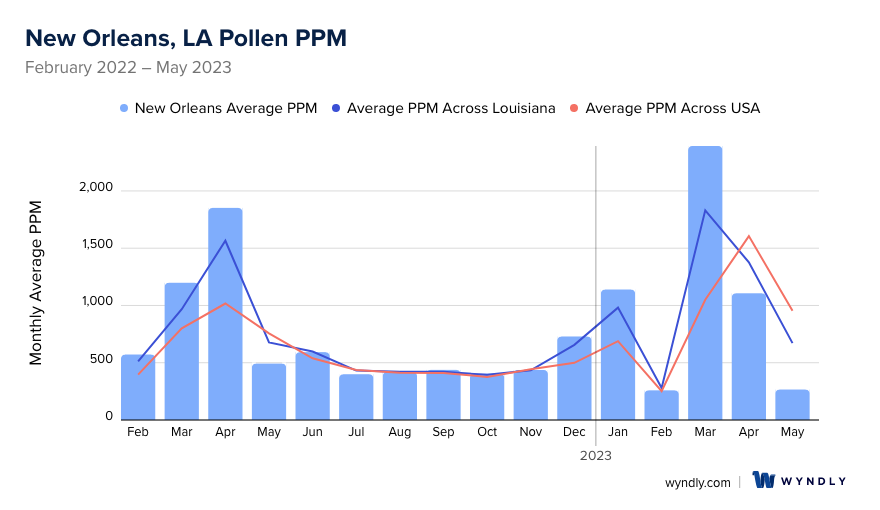
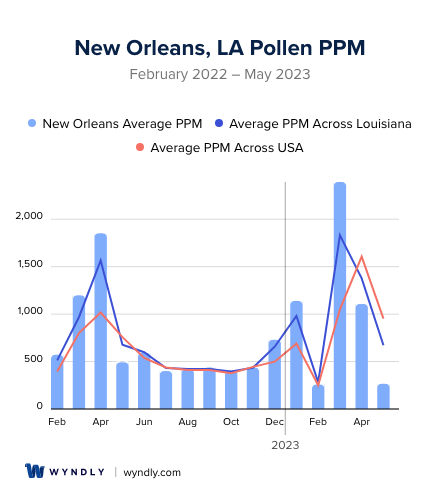
New Orleans, LA Pollen and Allergy Breakdown by Month
Grass
When is grass pollen highest in New Orleans, LA?
April has the highest grass pollen in New Orleans, LA with an average PPM of
When is grass pollen lowest in New Orleans, LA?
December has the lowest grass pollen in New Orleans, LA with an average PPM of
Tree
When is tree pollen highest in New Orleans, LA?
March has the highest tree pollen in New Orleans, LA with an average PPM of
When is tree pollen lowest in New Orleans, LA?
July has the lowest tree pollen in New Orleans, LA with an average PPM of
Weed
When is weed pollen highest in New Orleans, LA?
June has the highest weed pollen in New Orleans, LA with an average PPM of
When is weed pollen lowest in New Orleans, LA?
February has the lowest weed pollen in New Orleans, LA with an average PPM of
New Orleans, LA Pollen Monthly Breakdown by Pollen Type
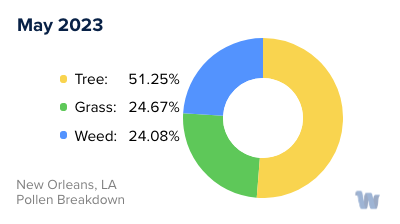
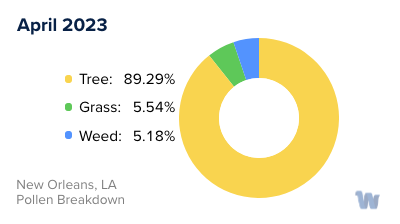
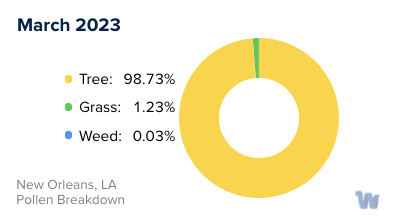
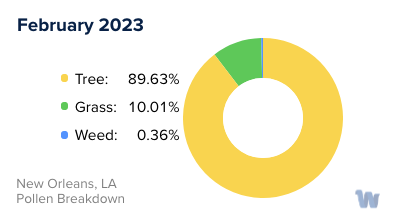
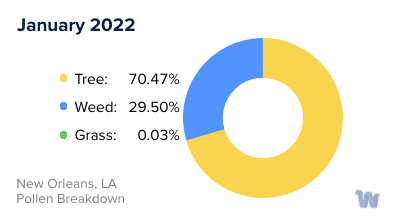
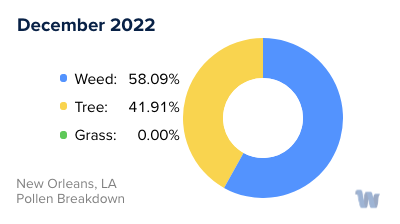
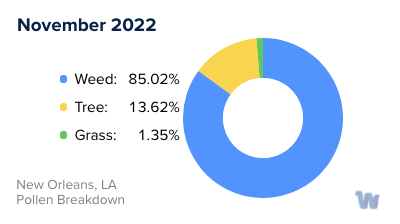
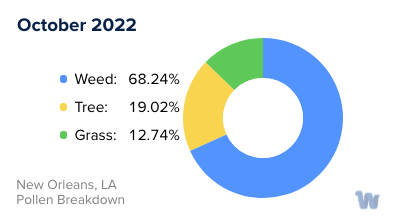
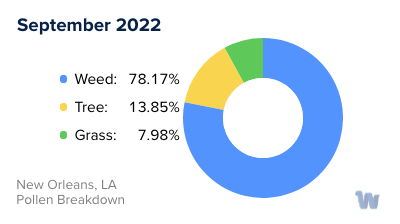
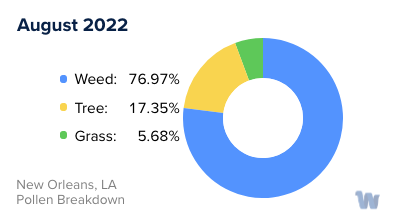
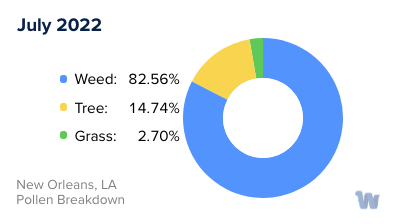
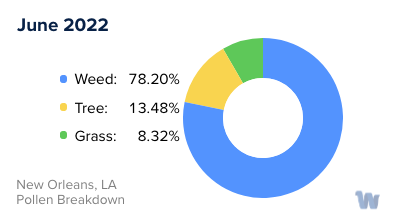
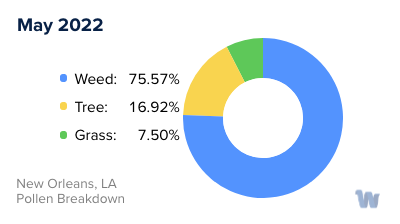
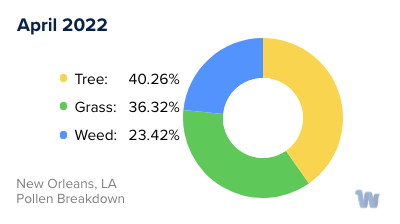
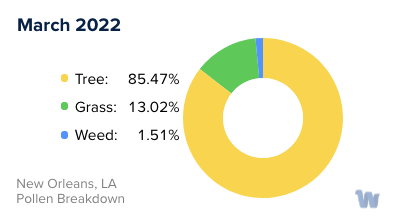
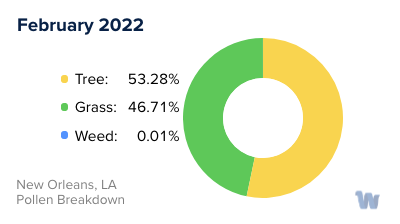
Pollen and Hay Fever in New Orleans, LA
As spring and summer unfurl their charms in New Orleans, Louisiana, the city's vibrant natural environment becomes a hotbed of pollination activity. This is an essential process for the local flora, but for those with pollen allergies, it can herald a season of discomfort, commonly known as hay fever.
The main culprits of pollen allergies in New Orleans are trees, grasses, and weeds. Each has its own particular pollination season, meaning that sensitive individuals can experience symptoms at varying times throughout the year.
Tree pollination in New Orleans typically begins in late winter and extends into spring. The city's diverse urban forest, featuring species such as oak, pine, and cypress, releases vast quantities of pollen into the air. Oak pollen is especially problematic due to its high volume and potency.
Following the tree pollination season, grasses take over the baton. In New Orleans, Bermuda grass, ryegrass, and Bahia grass are notable for their allergenic pollen. This grass pollination season typically peaks in late spring and early summer, although it can extend into the hotter months if the conditions are favorable.
Finally, as summer transitions into fall, weeds step into the pollen production spotlight. Ragweed is the most notorious, with a single plant capable of producing up to a billion grains of pollen in a season. Other problematic weeds include pigweed, sagebrush, and lamb's quarters.
The timing and severity of each pollination season can vary year to year based on weather conditions. Warmer temperatures and higher levels of carbon dioxide can stimulate plants to produce more pollen, while rain can help to clear pollen from the air. Windy conditions, on the other hand, can disperse pollen over a wider area.
In conclusion, understanding the cycles of pollen production in New Orleans can help those with pollen allergies anticipate and prepare for the changing seasons. Although this city is a vibrant, verdant wonder, it poses unique challenges for those sensitive to its natural rhythms.

